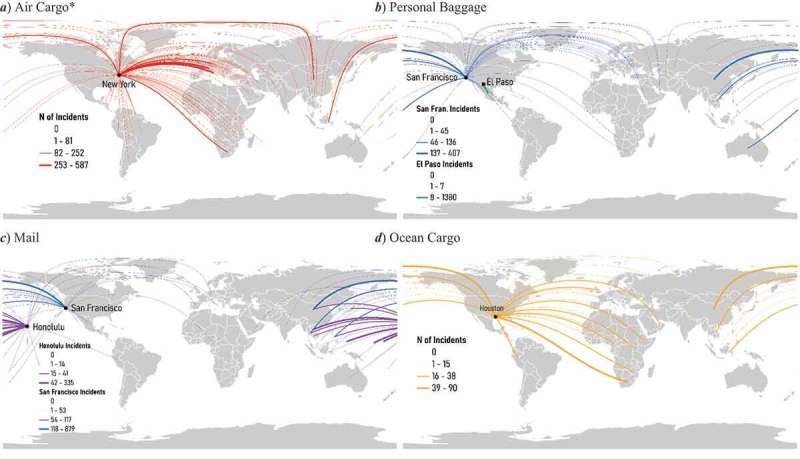This article has been reviewed according to Science X's editorial process and policies. Editors have highlighted the following attributes while ensuring the content's credibility:
fact-checked
trusted source
proofread
Conservation crime scientist uncovers secrets of trade threatening world's most endangered species

Trafficking of wildlife and wildlife products is estimated to be the fourth largest illegal trade in the world.
But this destructive, devastating billion-dollar trade that threatens many of the world's most endangered species still operates as somewhat of a mystery. What avenues are smugglers using to illegally move products, animals and plants from place to place? What countries are the biggest exporters? In which countries is demand the greatest?
These are some of the questions FIU conservation crime scientist Stephen Pires wanted to answer.
Pires—an associate professor in FIU's Steven J. Green School of International & Public Affairs—breaks down what he's uncovered about the trade in his latest study published in the journal Deviant Behavior.
How is wildlife being smuggled?
Air cargo accounted for the majority of all large-scale trafficking incidents. This confirms prior research we conducted. Other modes included personal baggage (like suitcases, backpacks, purses), mailed packages and ocean cargo, which accounted for 34% of seizures altogether.
Like air cargo, the second most common import method is personal baggage that passes through airports. Both of these modes of transport account for 83% of large-scale seizures in the U.S. indicating the need to concentrate efforts in airports in several cities that disproportionally account for most incidents.
How does the U.S. play a role in the illegal wildlife trade?
The United States is among the largest markets for both legal and illegal wildlife in the world. In this paper, we analyzed 31,270 large-scale trafficking incidents that occurred at U.S. ports over the course of a decade.
While this may seem like a lot of incidents, it's only the tip of the iceberg. What's seized is only a fraction of what is trafficked. It is estimated we are only seizing about 10% of total trafficked wildlife or wildlife products.
This study tracks those export trade flows to find patterns of large-scale wildlife trafficking entering the United States—not exactly the easiest thing to do. How did you approach this problem?
The U.S. Fish and Wildlife Service (USFWS) is primarily responsible for preventing wildlife trafficking in and out of the U.S. For decades, they've meticulously entered all seizure data documenting seized or confiscated wildlife entering and exiting the United States into a database called the Law Enforcement Management Information Service (LEMIS). Using this resource, we coded all shipments that could be considered "large-scale" seizures. The goal was to eliminate analysis of small-scale seizures that could have been accidentally brought to the U.S. by an unsuspecting tourist.
Then we formatted the dataset in a way that could be used for a social network analysis. It's basically a color-coded map that shows connections, so we can clearly see who the "central actors" in the supply chain are and which countries and ports of entry play a greater role in illicit supply chains.
Who were some of the 'central actors?'
Certain ports have emerged as important seizure hubs, regardless of transportation, like San Francisco and Los Angeles. Other U.S. entry ports, such as New York City, are highly dense and seized most illicit wildlife specifically by a single transportation mode like air cargo.
China, Mexico, and Southeast Asia (Indonesia, Thailand, and the Philippines) were identified as key exporting countries and should be targeted for anti-trafficking education campaigns.
We found removing just five ports from the overall network would disrupt over 66% of the illegal wildlife trade by each major mode of transportation.
How can your research guide enforcement efforts to stop illegal trade?
Trafficking patterns between major export regions and destinations remain complex and understudied, as are trafficking patterns between export countries and U.S. ports of entry. We hope this type of data can guide enforcement efforts to disrupt such networks by allocating more wildlife inspectors in potentially key U.S. ports of entry and prioritize inspecting particular modes of transport for wildlife trafficking.
How else can the illegal wildlife trade be stopped?
Apart from intercepting efforts in ports of entry, combatting the illegal wildlife trade takes many different forms.
Demand reduction campaigns in key demand countries attempt to dissuade people from wanting wildlife products emanating from endangered species. Alternatively, pressuring national governments to enforce current wildlife regulations within their borders has great potential to reduce poaching and trafficking in the most problematic places in the world.
Often, we see illicit wildlife markets in major cities in underdeveloped countries operating with impunity. Shutting these markets down would do much to reduce the trade even if some of this trade displaces to online or underground markets. Finally, promoting the legal trade of farmed species that are in great demand can potentially offset the illegal trade. This method has led to population rebounds for a number of highly endangered species, like the Nile crocodile and the vicuna, for example.
More information: Stephen F. Pires et al, A Social Network Analysis of Large-Scale Wildlife Seizures Made at US Ports of Entry, Deviant Behavior (2023). DOI: 10.1080/01639625.2023.2169211
Provided by Florida International University





















